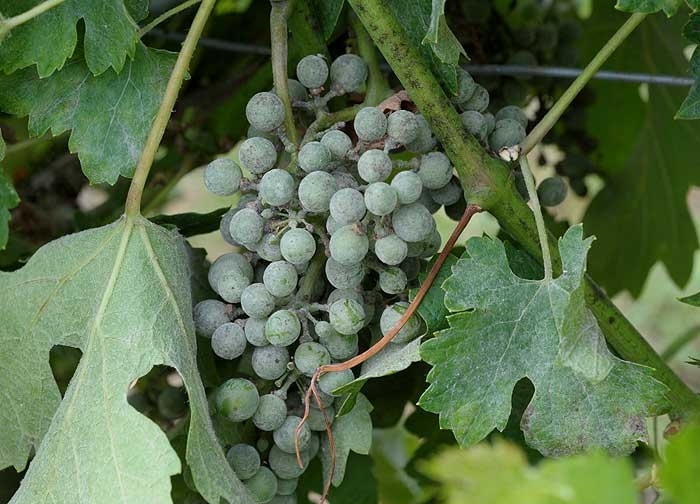
The appearance of white or gray plaque on grapes indicates damage to the plant by a fungal infection. Similar symptoms indicate diseases such as mildew and oidium. The causes of the appearance of the fungus on the stems, vines and leaves of the grape bush are many.
Most often, grapes become ill due to improper care.
Content
Reasons for the appearance
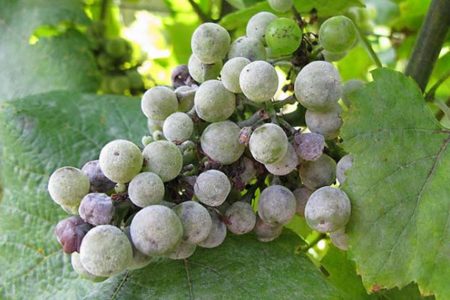
A fungus is a microscopic organism that spreads around the site using wind, rainfall and weed plants. It can exist for a long time in soil spores, while maintaining a static state that does not lead to infection of fruit crops. However, with the advent of comfortable conditions, fungal spores become more active and begin to multiply rapidly. The start for the development of the disease is, above all, the neglect of pruning grapes. In thickened plantings, where the vines are confused, and not enough light and fresh air passes through them, excessive humidity and stuffiness are often observed - favorable conditions for all types of fungi. In addition, the fungus infection can enter the vineyards through contaminated soil, which is rarely disinfected and fed; the remains of weeds that are not cleaned on time.
It should also be remembered that mainly weakened plants with weak immunity are subject to infection. This can be caused by a lack of nutrients or, conversely, their excess. This is especially true for nitrogen - if there is too much of this element in the earth, the vine bush is quickly suppressed.
The influence of weather conditions:
- mildew develops in warm and damp weather;
- Oidium does not depend on the level of humidity, but it favors temperature. For the development of infection, a temperature in the range of + 5-30 degrees is necessary;
- gray rot is activated in conditions of low temperature and high humidity;
- for alternariosis, stuffiness and dampness are favorable.
Signs of disease
No need to think that white plaque on grape leaves is just the beginning of the disease. At later stages, green leaves turn brown, and then completely die off. As soon as the fungus “eats” all the foliage, it will switch to shoots and fruits. Ignoring the disease can lead to the death of grapes within 30 days. Therefore, white oily matte spots on the vine and leaf blades should immediately alert, because this indicates a rapidly developing infection, which can lead to the death of the whole plant. You can verify the diagnosis by carefully examining all areas of the grape bush. Sporulation of different diseases looks different.
Oidium
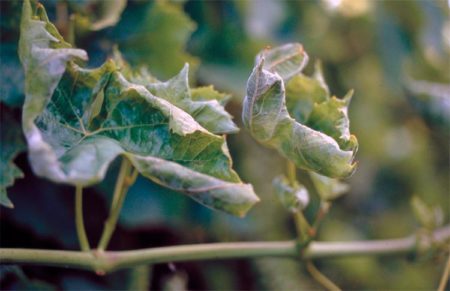
Powdery mildew sporulation looks like pubescent white spots that can appear not only on leaves, but also on stems, flowers, fruits. With the age of fungal spores, the spots begin to darken, and the infected areas coarsen and dry out. The leaf plate loses moisture, wrinkles, but does not fall, but remains on the bush, continuing to infect healthy areas that are still infected. If black dots begin to appear on the leaves, this indicates an imminent death of the plant. If the fungus spreads to fruits, then they will soon wither, you can’t eat berries. Productivity falls by 40-50%.
The danger of the disease is that it is not subject to ambient temperature. The fungus does not die even at sub-zero temperatures; it is able to overwinter in the plant tissues of grapes, and to activate in the spring.
Mildew
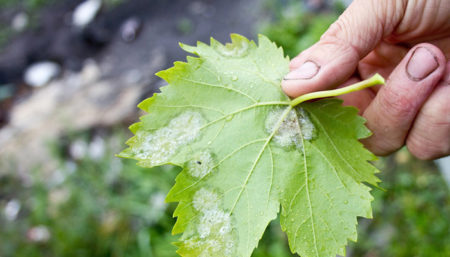
Powdery mildew is similar to an oidium only on the back of the leaf - this is where spores leave a powdery mildew. On the outside, spots of different sizes have an oily structure. The color is dirty yellow. Gradually diseased foci merge into one huge ulcer. Over time, the color changes to dark brown and even black. The sheet curls and falls. Mildew is also struck by flowers and berries - they completely dry out, becoming first blue, and therefore brown. The fungus first affects the upper part of the vine, gradually descending, capturing new territories. In most cases, at the time of detection of the disease, the bush is already so badly affected that it cannot be treated.
Alternariosis
This fungal disease does not spare any organ of the grape bush. Alternaria can be determined by the silver shade of the leaf plate. Gray spots contain necrosis that causes pathogens - parasites alternaria alternata and alternaria tenussima. They penetrate the tissues of weakened plants. If chemical treatments are not carried out, then the leaves and stems are covered first with light yellow, and then with rusty and brown spots. Then the shoots and leaves dry out. Then the fungus spreads from the leaves to the trunk and berries. The latter wrinkle, a metallic luster appears on them. If the weather is hot and humid, the bush may die in 5 days.
If during the harvest several infected berries fall into the container with the picked clusters, they will infect all the fruits during storage, resulting in spoiling all the grapes.
Emergency care for plants
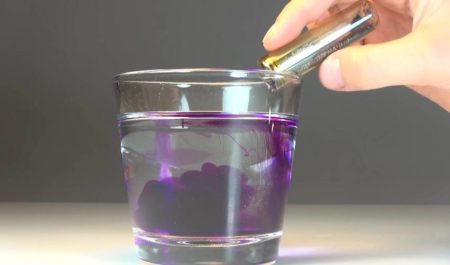
If you find foci of mycelium on the leaves of grapes, then first of all they need to be treated with a manganese solution. Spraying is carried out every two weeks, while abundantly filling all parts of the bush with useful fluid. Potassium permanganate, of course, will not completely heal the bush, but will significantly delay the reproduction of spores.
In parallel with the manganese solution, specialized preparations of a systemic mechanism of action are introduced. Their active substance will penetrate into the plant fibers and begin to fight the pathogen in a contact way.
If possible, then in a few days you can prepare a solution of humus, which also needs to be treated planting, if powdery mildew has been noticed.
Anti-Plaque Methods
When white plaque appears, no matter what disease it is caused by, it is recommended to start systematic spraying with sulfur-containing drugs. The fact is that sulfur absorbed by fungi transforms into hydrogen sulfide, which has a detrimental effect on mycelium. The sooner the treatment is carried out, the faster it will be possible to drown out the development of infection.
Sulfur-based products can be used as prophylaxis. To do this, prepare a solution of 40 grams of sulfur and 10 liters of water. When the first signs appear, a bucket of water already consumes 100 grams of sulfur. It is advisable to carry out sulfur treatment at a temperature of +20 degrees, otherwise it will evaporate poorly. However, at temperatures above 27 degrees, a sulfur solution can cause leaf burns. Processing is carried out 3-4 times per season with an interval of two weeks. Spraying is stopped when the berries begin to ripen on the bush.
One of the most effective inorganic fungicides is colloidal sulfur. She successfully fights gray rot, oidium and mildew. It also stops spider mites.Vapors of colloidal sulfur penetrate the fungal organism and destroy it from the inside. however, the plant itself does not suffer. For processing grapes, the consumption rate of the drug is 80 grams per 10 liters of water. The resulting concentrate is enough for irrigation of 60 square meters of land. The number of treatments per season is no more than 5.
If a white coating has just appeared, then spraying the bushes with a 1% solution of Bordeaux liquid will help stop sporification. This tool is preferably used regularly, starting in early spring, as soon as the winter shelter was removed. If it’s cool outside, it is best to use colloidal sulfur.
If the grape bushes are young enough and have not grown too large, then they can be processed with milk whey, which has proven itself in the fight against various fungi. Spraying should be carried out in the middle of the day, since milk protein is activated in the sun. Against powdery mildew, a whey solution is prepared at the rate of: 1 part milk to 3 parts water. The bushes are watered generously with the solution so that the liquid drips from the leaves. Natural fungicide is absolutely safe for plants, and therefore useful treatment can be carried out often, every 7-10 days.
Against oidium, ready-made chemicals are mainly used. The best include Acrobat, Skor, Topaz, Tilt, Topsin, Tiovit Jet, Hom, Oksikhom and others. Usually, these agents carry out double treatment, which is enough to drown out the spread of the disease.
Topaz, Ronilan, Topsin-M, Rovral are called to cope with gray rot. These drugs have a strong chemical effect on the fungus, but often cause resistance in a particular pathogen. Therefore, these funds need to be alternated with each other so that the fungus does not have time to get used to the chemical composition. If flowers or fruits began to rot, then they must be treated with one of the drugs based on captan, folpet, captafol.
If you are dealing with alternariosis, it is preferable to choose copper-containing preparations for the treatment of grapes. Copper-soda solution, which is prepared from soda ash (50 grams), grated soap (200 grams) with the addition of copper sulfate (10 grams), previously diluted in water, copes well with the disease. Also in spring, fungicides with the active substance mancozeb of contact action are used (Mankodim, Order of the MC, Rapid Gold, Ridomil Gold, Ditan M-45). If the fungus penetrated into the plants, then systemic fungicides - Skor, Quadris, Strobi, Horus - will help in the fight against it.
Preventative measures
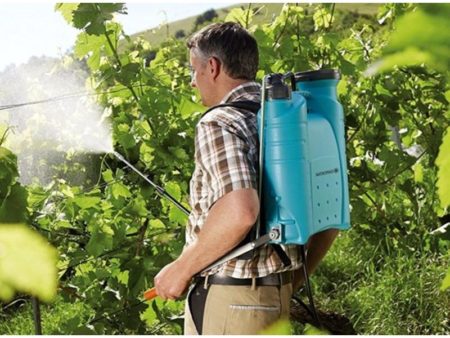
The appearance of painful plaque can be prevented with the help of preventive measures. So at the beginning of summer, an ash solution is sprayed. The tool is prepared from 1 kilogram of wood ash and a bucket of water. For better adhesion, grated soap is added to the mixture.
Iodine is able to prevent the appearance of oidium and mildew. A solution based on it is prepared from 10 liters of water and 10 milliliters of iodine. A popular preventive biological agent is Fitosporin-M. They are sprayed with plants throughout the season.
In addition to useful spraying, it is important to observe agricultural literacy:
- destroy plant weed residues on which fungal spores are localized. It is necessary to take all the grass outside the garden and burn it;
- do not plant crops close to grapes that are more susceptible to fungal diseases;
- buying grape seedlings for planting, choose healthy and well-developed bushes;
- sanitize in early spring and fall. In the summer, timely break out branches and stepsons that thicken the bush. Do not overcrowding;
- use a sterile tool for trimming. Before proceeding with pruning to the next bush, sanitize the pruner;
- water the grapes early in the morning so that the leaves dry out in a day;
- feed the grapes correctly - nitrogen is required only at the first stage of the growing season. Then the plant will need only phosphorus and potassium supplements.
Will the affected grapes live
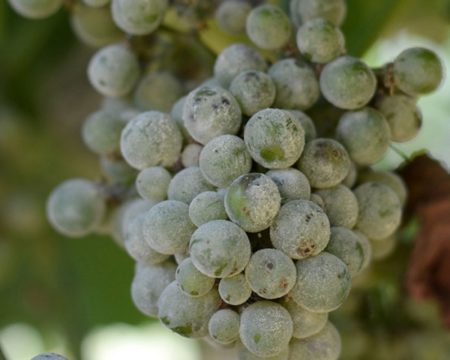
Unfortunately, fungal diseases are difficult to treat. This is due to the fact that most often they are noticed on grapes, when the infection has almost completely taken possession of it. It is impossible to cure such grapes, so you should not even waste time on futile attempts. Remember that while you sort through fungicidal preparations, the fungus is already marking on healthy bushes. Therefore, it is better to remove heavily affected plants and direct all attention to saving still healthy bushes.
The land that has become empty after grape removal is carefully cultivated. They dig it up, disinfect it, make complex mineral fertilizers. In this place, it is not recommended to plant any plants over the next two years. During this time, the earth will "rest" and get rid of harmful microorganisms.
Conclusion
If on the grape bushes foci of sporulation began to appear everywhere, then not only general agricultural techniques, but also the use of strong fungicides are needed. However, there are cases that even pesticides are not able to cope with the disease. There is only one way out - to remove the affected plants from the site.

 Non-covering winter-hardy grape varieties for Moscow region
Non-covering winter-hardy grape varieties for Moscow region How to keep the vine in winter
How to keep the vine in winter When can I transfer grapes to another place in the fall
When can I transfer grapes to another place in the fall How to cover and prepare grapes for the winter in the suburbs
How to cover and prepare grapes for the winter in the suburbs